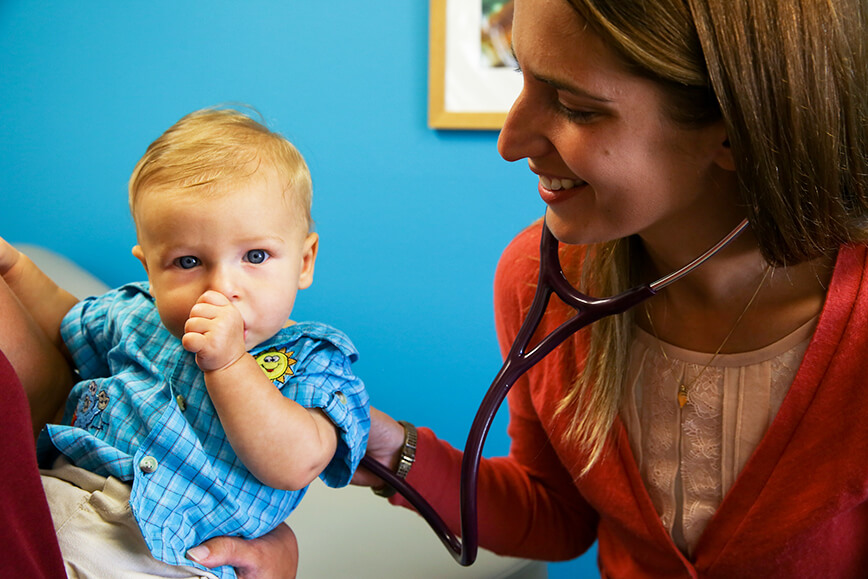A newborn baby is the greatest miracle of life. There is nothing more incredible and supernal than the creation of a new human being. Newborns enter a world of many dangers and their small bodies are as yet unproven in competency to deal with many trials. The infant’s intestines have not yet been tested with the volumes needed to maintain growth (we’ll discuss bowel problems next week). The baby’s hormone system, heart, and blood vessels, and immune system have yet to prove themselves healthy in adapting to life outside the womb.
Parents must be careful observers for signs of problems that may manifest after discharge from the hospital. The health care staff at the hospital, including your doctor, will evaluate your baby for any outward signs of problems. Many tests will be done to check for any hidden abnormalities, but not all problems can be detected before discharge. Parents may naturally assume that with the sophistication of health care they can be reassured that all will be well. Although this is generally true, there are some problems for which parents must be vigilant and will be the first line observer to warn of dangers. Intestinal obstruction is one that I’ll discuss next week. Today I would like to talk to you about serious infections that may jeopardize your infant and how to recognize them.
Sepsis is the leading treatable cause of death in infancy. Partially preventable causes that are more common are Sudden Infant Death Syndrome which I discussed last week and injury. A 2005 population study of sepsis revealed over 42,000 cases in the U.S. in youth with 4,400 deaths, approximately 7% of the total death rate. The incidence is likely lower now with improved vaccine rates and perinatal care measures to prevent infection. Despite its danger, frequency, and treatability there are no studies that I could find investigating parents’ ability to detect this problem at home. Identifying sepsis is a particular challenge because the symptoms all mimic other problems. The main symptoms are fever over 100.4 F rectal, low body temperature less than 96.8 rectal, fast heart rate, decrease activity and consciousness, and fast or labored breathing.
Septic shock is an insidious and dangerous hazard. You must understand this process and how it affects the body. Bacteria enter the child and begin to grow in the lungs, blood, urine, or spinal fluid. These bacteria grow in an increasingly rapid fashion and can cause your infant to get sick very fast. As the bacteria continue to grow, so does the danger. The body’s reaction to the bacteria can cause the blood vessels to become leaky to the point that they can’t keep the blood pressure high enough to bring oxygen and nutrients to vital organs.
The urgency and emergency of treating sepsis depend upon the reserve and health of the child, the immune function, and the level of exponential bacterial growth in the body. Newborns up to 3 months of age are at especially high risk of complications and death from sepsis because their little bodies have naive immune systems and they have a little reserve to cope with serious disease. Fever does not equal sepsis, but it is a sign of urgency in a child less than 3 months old. Ten percent of babies less than 90 days old with a fever will have a serious bacterial infection, and if left without prompt treatment may progress to septic shock. Fever is a temperature taken rectally that is over 100.4 degrees Fahrenheit or 38 degrees centigrade. See information on how to take a rectal temperature below.
It is not necessary to routinely take your child’s temperature; only if he feels warm or cold or acts sick. Any child less than 90 days old with a fever should be seen by a physician promptly.
Unfortunately, fever is not the only symptom that you have to watch for to indicate that your newborn may have an infection that could lead to septic shock. Some sick infants will only develop a fever once and for a short period of time so it is possible to miss a fever. Some newborns will have low body temperature with other signs of illness. Hypothermia or low temperature is a temperature less than 36 degrees Celsius or 96.8 degrees Fahrenheit.
Other symptoms of illness in newborns can be subtle and difficult to discern as problematic. Newborns have very responsive heart rates and can elevate quickly in response to discomfort, excitement, etc. Normal awake heart rates can be from 85 to 205 depending on the activity state of the child. Normal sleeping heart rates can be from 80 to 160. Baby’s heart rates can be a challenge to measure because it can be so fast.
Decreased activity and consciousness as a symptom of disease can be a challenge because newborns sleep the majority of the time, and when in a deep sleep they can be hard to arouse. Most babies don’t have predictable and consistent sleep-wake cycles until three to four months of life. Some babies periodically have longer than typical sleep periods which can be normal. When your baby is awake she should look, act, and feed like her normal self.
Breathing patterns in newborns can likewise be hard to assess for parents because they can be erratic. Some babies have a normal breathing pattern called periodic breathing when they sleep. This is a pattern of fast flutter breathing alternating with pauses in breathing up to 15 seconds. Some infants will tummy breath which can look abnormal. Normal breathing rates in young infants are up to 60 breaths per minute. It may be normal for some babies to briefly breathe faster than this if they are excited or have periodic breathing but a breathing rate over 60, especially with labored respirations, should not be sustained. There are some videos demonstrating normal and abnormal breathing at the end of the blog.
The subtlety of sepsis onset and the explosive nature of its finish present a terrifying challenge to parents and doctors alike. Here are a few pearls that I believe will help.
1. Sepsis is progressive. If your infant seems a little more tired than usual, or a bit more warm but doesn’t register a fever, or has intermittent faster breathing but doesn’t seem abnormal – then watch frequently and carefully. If there is any sign of worsening have your baby seen urgently.
2. In the progression of sepsis, symptoms will eventually combine. If your baby has a faster than typical heart rate but seems happy, that is not likely sepsis. If your baby seems to have mild labored breathing but looks good, that is not likely sepsis. If your child develops a fever over 100.4 F rectally and has no other symptoms, that is still not likely sepsis. But if you start to combine symptoms you may have a tiger by the tail and need emergent evaluation. Especially in need of rapid evaluation are infants with fever, fast heart rate, or those looking ill with decreased activity. In my experience, persistent rapid or labored breathing developing in addition to these symptoms is a foreboding sign of rapid deterioration.
3. Sepsis symptoms are a change from normal appearance and functioning. You will know your infant best and how she acts, breathes, feeds, feels, etc. If she seems to not behave normally, have her seen by a doctor. If changes are subtle and you’re not sure if there is a problem, it’s not likely an emergency but watch carefully for the progression of symptoms.
4. Don’t be falsely confident that sepsis won’t occur because your child was recently evaluated by a health provider. Some people feel inappropriately convinced that everything will be ok because they have interacted with a sophisticated health care system. Remember, sepsis is a progressive problem and the onset is subtle with its individual and separate symptoms presenting in many other illnesses. Doctors depend on parents, at home and even in the hospital, to help monitor for worsening of symptoms and combining of symptoms that may indicate the progressive disease of septic shock. If you feel your child’s condition is worsening from when she was seen by the doctor, call or have her seen again.
5. Your infant less than 3 months old has a naive system and must be seen urgently with any rectal fever over 100.4 F or under 96.8 F, rapid or labored breathing, or decreasing activity or level of alertness when awake. Your infant must be seen emergently if these symptoms are progressing and/or combining.
6. The best prevention for sepsis in young infants is good prenatal care, hand hygiene, vaccinations, and avoiding contact with sick people. If the contact is unavoidable, make sure the sick person wears a mask and uses good hand hygiene. Begin immunizations at two months of age because these vaccines prevent some bacterial infections that can cause sepsis in addition to other complications such as brain damage and deafness.
I blog about the serious things that can cause you misery because I want you to understand them so you can worry about them less. Sepsis is still a rare event, like getting in a car wreck. I want you to maximally enjoy the precious time you have with your newborn baby. Your baby grows up so fast, so treasure every minute and let us know if you have any concerns.
Proper hand-washing
http://www.cdc.gov/handwashing/when-how-handwashing.html
The U.S. Centers for Disease Control and Prevention recommend the following steps for hand-washing:
1. Wet your hands with running water and apply soap.
2. Rub your hands together to make a lather. Scrub well for at least 20 seconds.
3. Pay special attention to your wrists, the backs of your hands, between your fingers, and under your fingernails.
4. Rinse your hands well under running water.
5. Use a clean towel to dry your hands, or air-dry your hands.
You may want to leave the water running while you dry your hands on a paper towel. Then use the paper towel as a barrier between the faucet and your clean hands when you turn off the water.
If soap and water are not available, use a hand sanitizer or alcohol-based hand wipe that contains at least 60{81e69a3ca26977ac766aed87a28b2a1ecd92f9787a94c83a7ea2b436f670aee6} ethyl alcohol or isopropanol. Carry one or both with you when you travel, and keep them in your car or purse. These products can help reduce the number of germs on your hands, but they do not get rid of all types of germs.
If you use sanitizer, rub your hands and fingers until they are dry. You don’t need to use water. The alcohol quickly kills many types of germs on your hands.
REFERENCES
An Emergency Department Septic Shock Protocol and
Care Guideline for Children Initiated at Triage
PEDIATRICS Volume 127, Number 6, June 2011
Serious Bacterial Infections in Febrile Infants 1 to 90 Days Old With and
Without Viral Infections
PEDIATRICS Vol. 113 No. 6 June 2004
Scope and epidemiology of pediatric sepsis
Pediatr Crit Care Med 2005 Vol. 6, No. 3 (Suppl.)
http://www.cdc.gov/injury/wisqars/pdf/leading_causes_of_death_by_age_group_2014-a.pdf
NEWBORN BREATHING VIDEO
This is a healthy baby with occasional tummy breathing. Notice the breathing is effortless and you don’t see the chest move much with each breath. The baby is happy.
http://www.bing.com/videos/search?q=normal+newborn+breathing+patterns&&view=detail&mid=EA92DAED1539D48B3A49EA92DAED1539D48B3A49&FORM=VRDGAR
ABNORMAL BREATHING
This is labored breathing in an older infant. Notice the chest move up and down excessively and the retraction or sinking in of the skin between the ribs.
NORMAL OR ABNORMAL?
This baby has a fast breathing rate of about 70 breaths per minute. The breathing in intermittently fast with pauses. The chest moves up and down more than most babies and you can see some retractions. The infant has some upper airway congestion. The baby is active and appears happy.
This presents the complexity of the symptoms babies present. This breathing is likely perfectly normal for this child. He have developed some recent nasal congestion worsening his breathing. If this was a new pattern of breathing for this baby he should be seen by the doctor.
NORMAL PERIODIC BREATHING
This infant is sleeping, has normal baby wiggles and is not distressed. You see some tummy breathing. He has mild upper airway congestion. You will notice periods of pauses about ten seconds followed by faster breathing rates. This is likely a normal breathing pattern for this baby. If he had never breathing like this before I would still have him evaluated.
LARYNGOMALACIA AND FAST BREATHING WITH EXCITEMENT
This baby has something called stridor which is an upper airway noise likely form laryngomalacia. He is happy and breaths very fast when excited. This is likely normal breathing for him but if it was a new breathing pattern I would have him evaluated.
How to Use a Digital Multiuse Thermometer
Rectal temperature
If your child is younger than 3 years, taking a rectal temperature gives the best reading. The following is how to take a rectal temperature:
- Clean the end of the thermometer with rubbing alcohol or soap and water. Rinse it with cool water. Do not rinse it with hot water.
- Put a small amount of lubricant, such as petroleum jelly, on the end.
- Place your child belly down across your lap or on a firm surface. Hold him by placing your palm against his lower back, just above his bottom. Or place your child face up and bend his legs to his chest. Rest your free hand against the back of the thighs.
- With the other hand, turn the thermometer on and insert it 1/2 inch to 1 inch into the anal opening. Do not insert it too far. Hold the thermometer in place loosely with 2 fingers, keeping your hand cupped around your child’s bottom. Keep it there for about 1 minute, until you hear the “beep.” Then remove and check the digital reading.
- Be sure to label the rectal thermometer so it’s not accidentally used in the mouth.
This description of taking a rectal temperature is from the AAP website healthy children.org.



